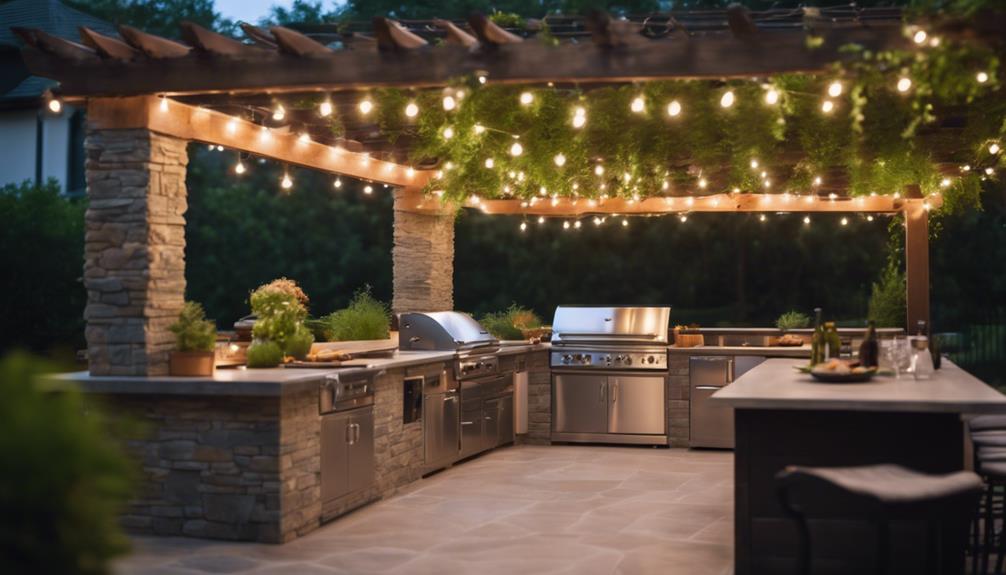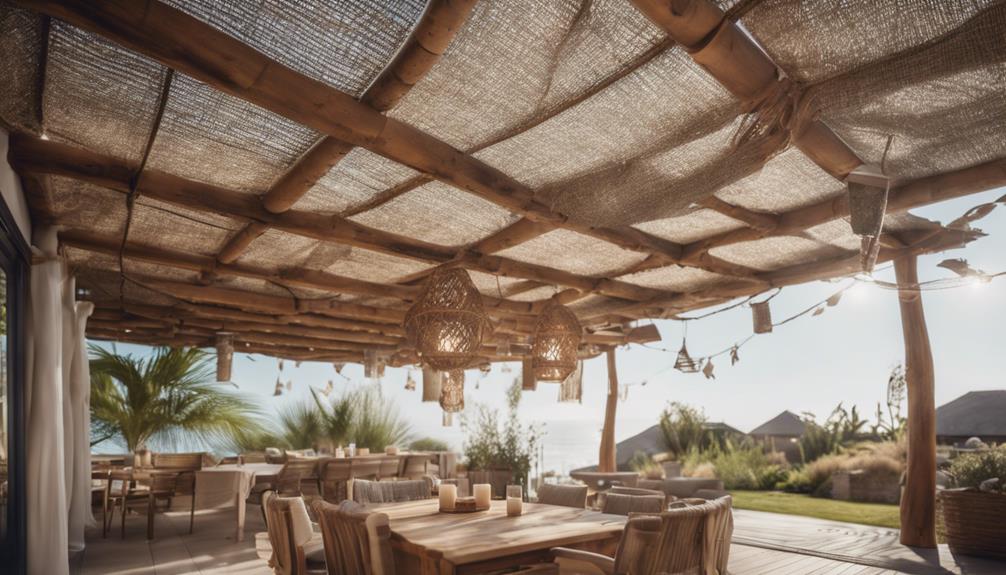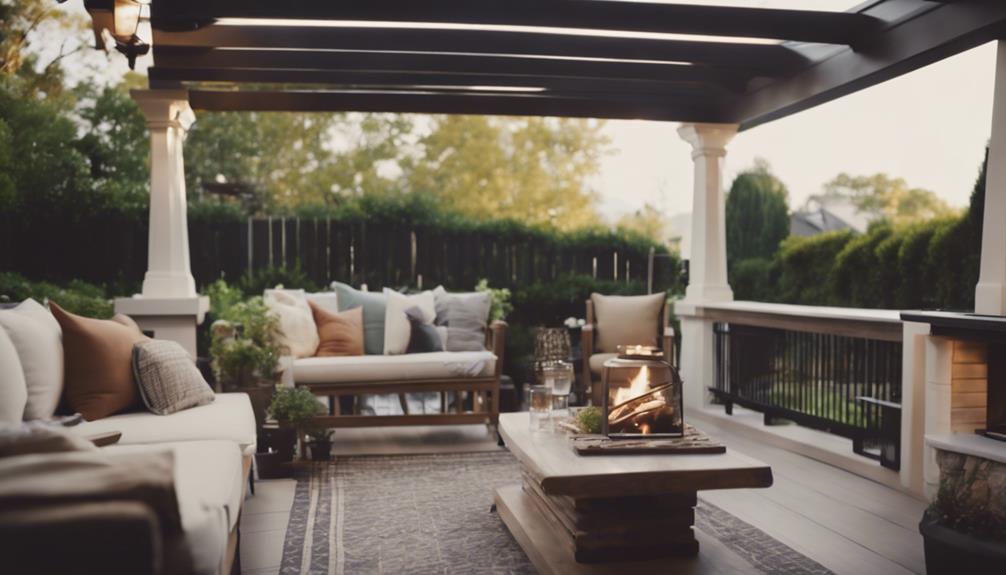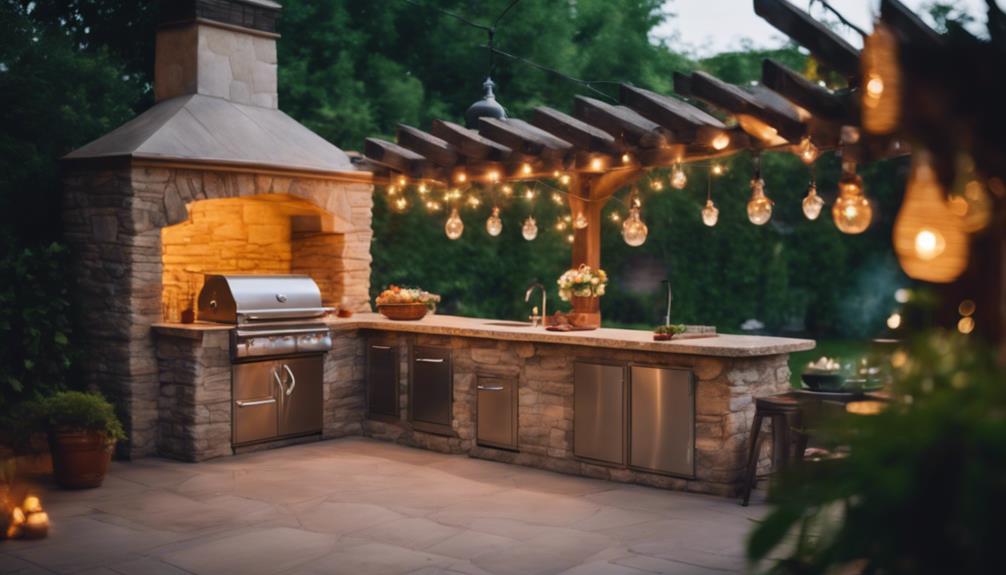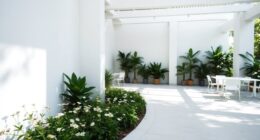You're ready to turn your backyard into an alfresco kitchen oasis! From advanced appliance integrations to seamless indoor-outdoor connections, the top trends for outdoor cooking spaces are all about convenience, luxury, and entertainment. Functional peninsula designs and outdoor pantry storage solutions guarantee effortless cooking and socializing. Integrated entertainment spaces and wind-resistant design considerations mean you can relax and enjoy the outdoors, no matter the weather. With high-performance countertop materials, your outdoor kitchen will be the perfect blend of form and function. Want to know more about how to bring these trends to life?
Key Takeaways
- Advanced appliance integrations, like built-in fridges and kegerators, elevate outdoor kitchens with luxury and convenience.
- Seamless indoor-outdoor transitions are achieved through sliding glass doors, merging spaces and enhancing natural light and views.
- Functional peninsula designs improve workflow, featuring built-in grills, sinks, and storage for efficient outdoor cooking and entertaining.
- Outdoor pantry storage solutions, with sliding doors and organized storage, streamline cooking experiences and keep essentials within reach.
- Integrated entertainment spaces merge cooking, dining, and socializing areas, prioritizing functionality, convenience, and relaxation for outdoor gatherings.
Advanced Appliance Integrations
When designing your alfresco kitchen, incorporating advanced appliance integrations is key to elevating your outdoor cooking space into an entertainment hub. You want your outdoor kitchen to be more than just a grill and some countertops, right? By incorporating advanced appliances, you'll create a space that's perfect for socializing and entertaining.
Outdoor appliances like built-in fridges, wine coolers, and kegerators will take your outdoor kitchen to the next level. Imagine being able to store your favorite beverages at the perfect temperature, or having a fridge stocked with your favorite snacks. Modern outdoor kitchens are all about convenience and luxury. With these advanced appliances, you'll be the envy of all your friends and family.
Plus, they'll make entertaining a breeze. So, don't settle for a basic outdoor kitchen – go all out and create an alfresco space that's truly unforgettable!
Seamless Indoor-Outdoor Transitions
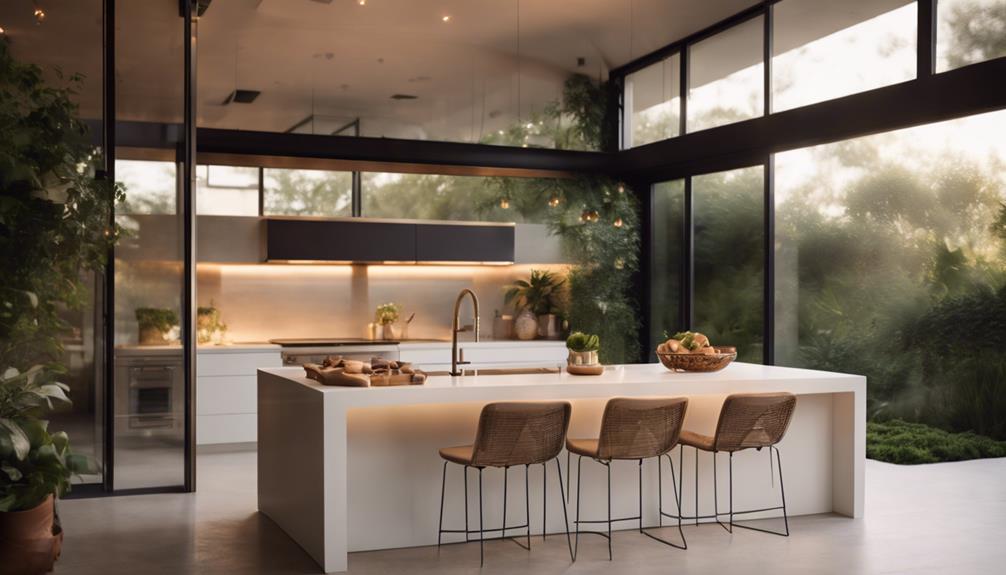
Now that you've got your outdoor kitchen set up with advanced appliances, it's time to think about how to blend the indoor and outdoor spaces seamlessly.
You want to create a flow that's as smooth as a summer breeze, and that's where sliding glass doors and matching flooring choices come in.
Sliding Glass Doors
With sliding glass doors, you can effortlessly merge your indoor and outdoor spaces, creating a harmonious flow that transforms your kitchen area into a bright and airy oasis.
As you step into your alfresco kitchen, the seamless shift between indoor and outdoor living spaces is a game-changer. These sleek doors allow natural light to flood your kitchen, making it feel more spacious and connected to the outdoors.
You'll love how they provide unobstructed views of your outdoor space, making you feel like you're cooking amidst nature. Plus, sliding glass doors are super customizable, so you can choose the perfect fit for your kitchen's unique style and size.
Whether you're going for a modern, sleek look or a cozy, rustic vibe, these doors will blend in beautifully. By incorporating sliding glass doors into your alfresco kitchen design, you'll be creating an Al Fresco haven that's perfect for outdoor living and cooking.
Matching Flooring Choices
As you design your alfresco kitchen, choosing the perfect flooring is essential to creating a smooth shift between indoor and outdoor spaces. You want to make sure that your outdoor living area flows seamlessly into your indoor kitchen, and the right flooring can make all the difference.
When it comes to outdoor kitchen flooring, durability is key. You'll want materials that can withstand the elements and heavy foot traffic. Porcelain tiles are a popular choice, offering easy-to-clean surfaces and impressive durability. Natural stone pavers provide a slip-resistant surface, ensuring safety in all weather conditions.
If you're looking for a low-maintenance option, composite decking is a great choice, offering both beauty and functionality. And if you want a customizable look, stained concrete is the way to go. Whatever you choose, make sure it's heat-resistant to withstand those sizzling summer barbecues.
Functional Peninsula Designs
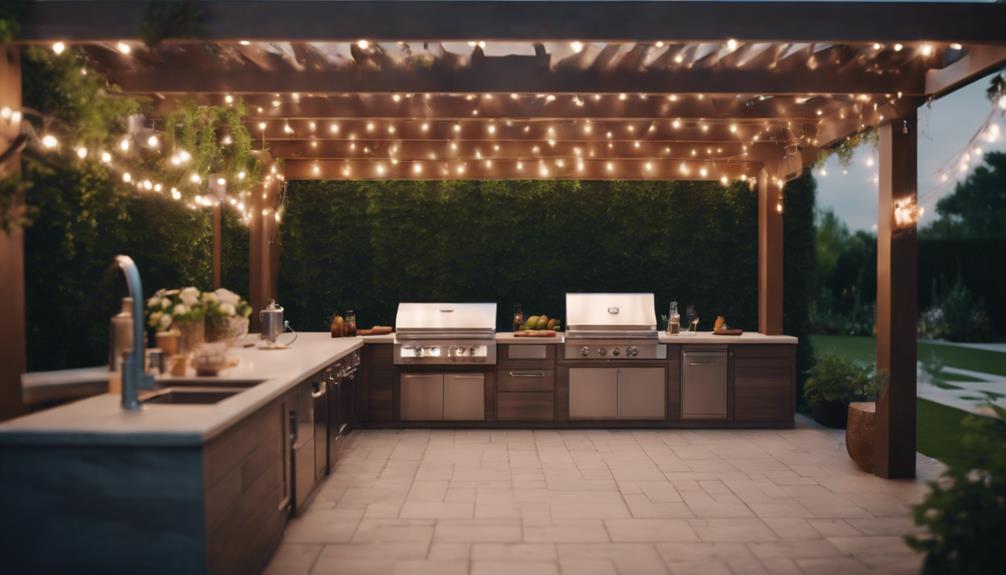
By incorporating a functional peninsula design into your alfresco kitchen, you can create a seamless flow between cooking, serving, and dining areas while maximizing efficiency and social interaction. This clever layout choice allows you to cook, serve, and socialize all in one convenient spot.
Plus, peninsulas can include built-in grills, sinks, and storage options, making your outdoor cooking space super efficient. You'll love how peninsula designs enhance the overall aesthetic appeal and functionality of your outdoor space. And, with durable countertop materials like granite or quartz, maintenance is a breeze.
Imagine having a dedicated area for food prep, cooking, and serving, all while enjoying quality time with family and friends. Peninsula designs make it happen, fostering social interactions and memories that'll last a lifetime.
Outdoor Pantry Storage Solutions
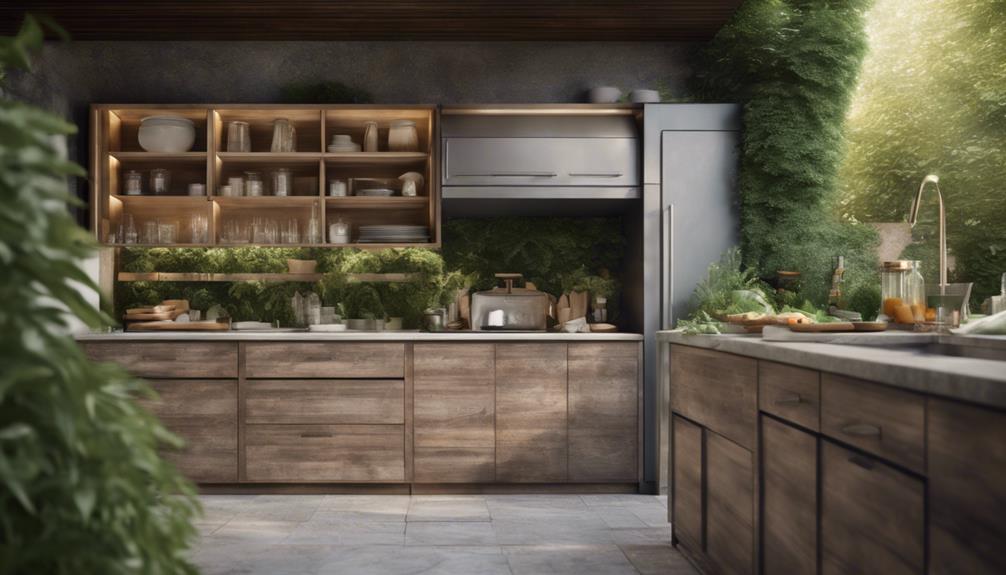
You'll appreciate the convenience of having all your outdoor cooking essentials at your fingertips with an outdoor pantry storage solution, which provides a dedicated space for fuels, cutlery, snacks, and grilling accessories. This means you can focus on cooking up a storm without constant trips to and from the indoor kitchen, freeing you up to enjoy your outdoor gatherings.
Here are just a few benefits of incorporating an outdoor pantry into your alfresco kitchen:
- Sliding doors protect your essentials from the elements, keeping them clean and dry.
- No more cluttered countertops, with everything neatly stored away.
- Streamlined cooking and dining experiences, thanks to having everything you need right at hand.
With an outdoor pantry, you'll be amazed at how much more functional and efficient your outdoor kitchen becomes. No more rummaging around for utensils or ingredients – everything is neatly organized and within easy reach. This is especially important when hosting outdoor gatherings, where you want to focus on having fun with your guests, not scrambling to find what you need.
Integrated Entertainment Spaces
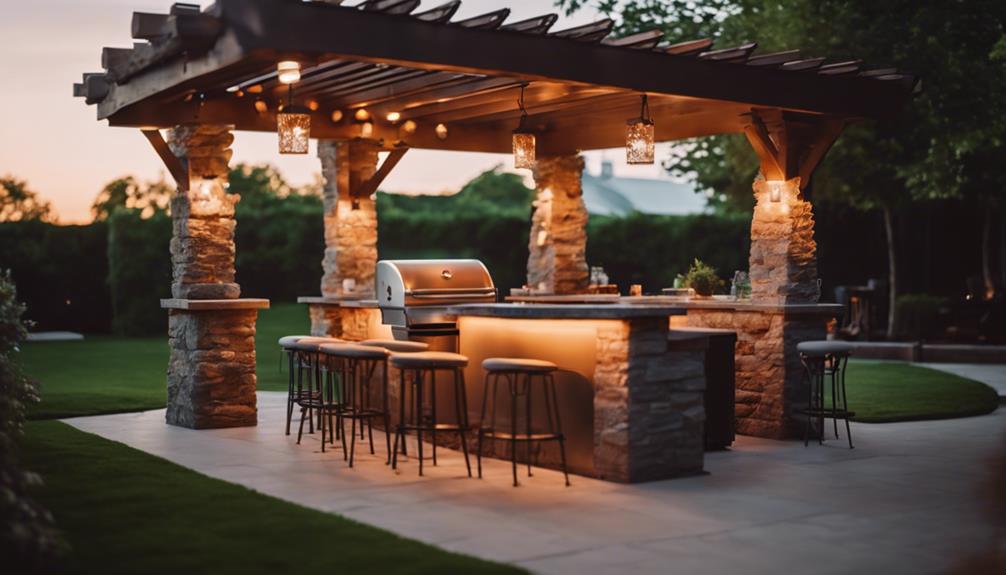
When designing your alfresco kitchen, incorporating an integrated entertainment space allows you to seamlessly merge cooking, dining, and socializing into one cohesive experience. Imagine having a functional outdoor space where you can cook, eat, and hang out with family and friends – all in one spot! Integrated entertainment spaces in outdoor kitchens are designed to do just that. They typically feature comfy seating, ambient lighting, and design elements that encourage relaxation and connection.
These spaces are perfect for gatherings of all sizes, from intimate dinners to larger parties. The layout and design prioritize functionality, convenience, and the overall enjoyment of outdoor living. By incorporating an integrated entertainment space into your outdoor kitchen, you'll create a welcoming environment that enhances the overall ambiance and encourages socializing.
Whether you're hosting a dinner party or just enjoying a casual evening with loved ones, your outdoor living space will become the go-to spot for making memories.
Wind-Resistant Design Considerations
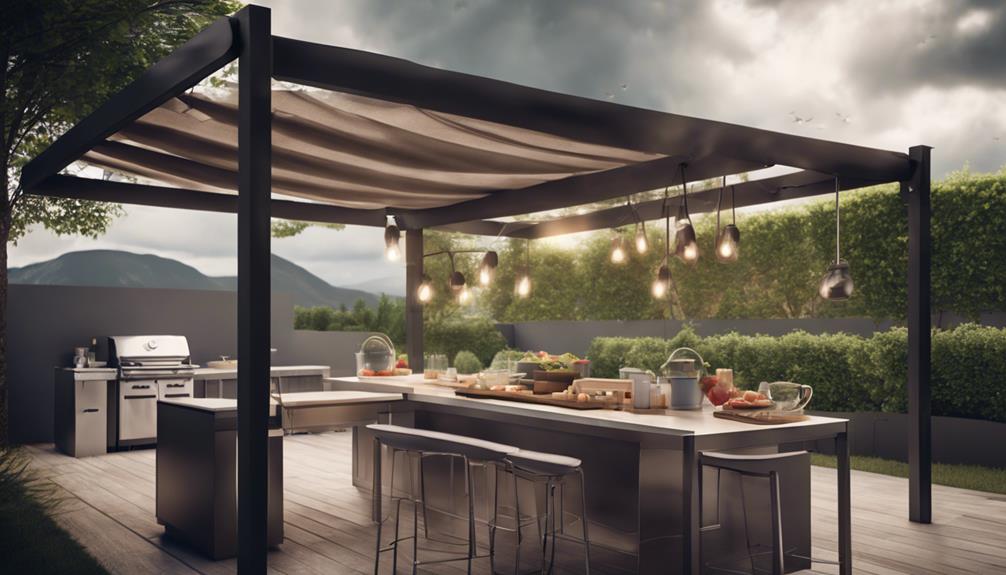
As you design your outdoor kitchen, you'll want to make sure it can withstand those gusty days. That's where wind-resistant design considerations come in, and it all starts with ensuring your structure is secure.
From choosing sturdy materials to strategically placing your furniture, you'll be cooking up a storm in no time!
Structural Integrity Matters
Designing an alfresco kitchen that can withstand strong winds requires careful consideration of structural integrity, starting with the selection of durable materials like concrete, steel, or stone. You'll want to guarantee that your outdoor cooking space can resist harsh weather conditions, so it's crucial to choose materials that can stand up to the task.
To take it a step further, consider the following wind-resistant design considerations:
- Proper anchoring: Make sure your outdoor kitchen structures are securely anchored to the ground to prevent them from toppling over in strong winds.
- Wind-resistant features: Incorporate features like solid roofs, sturdy pergolas, or retractable awnings to provide protection during windy conditions.
- Wind load calculations: Perform wind load calculations to ensure your alfresco kitchen meets safety standards and can withstand strong winds without sustaining structural damage.
Secure Outdoor Furniture
You'll need to select outdoor furniture that can withstand strong winds and harsh weather conditions, opting for wind-resistant pieces that are specifically designed to prevent toppling over in gusty weather. When it comes to outdoor kitchens, having furniture that can withstand the elements is essential. Wind-resistant outdoor furniture is designed to do just that, with features like weighted bases, sturdy materials, and secure fastenings to prevent toppling over in windy conditions.
Materials like aluminum, teak, and resin wicker are commonly used for wind-resistant outdoor furniture, ensuring your outdoor kitchen setup remains stable and secure. Don't forget about umbrellas and canopies with wind vents, which allow wind to pass through without causing damage.
Proper maintenance and storage practices can also prolong the lifespan of your wind-resistant outdoor furniture. By choosing the right materials and designs, you can create an outdoor kitchen space that's both beautiful and functional, even in harsh weather conditions.
High-Performance Countertop Materials
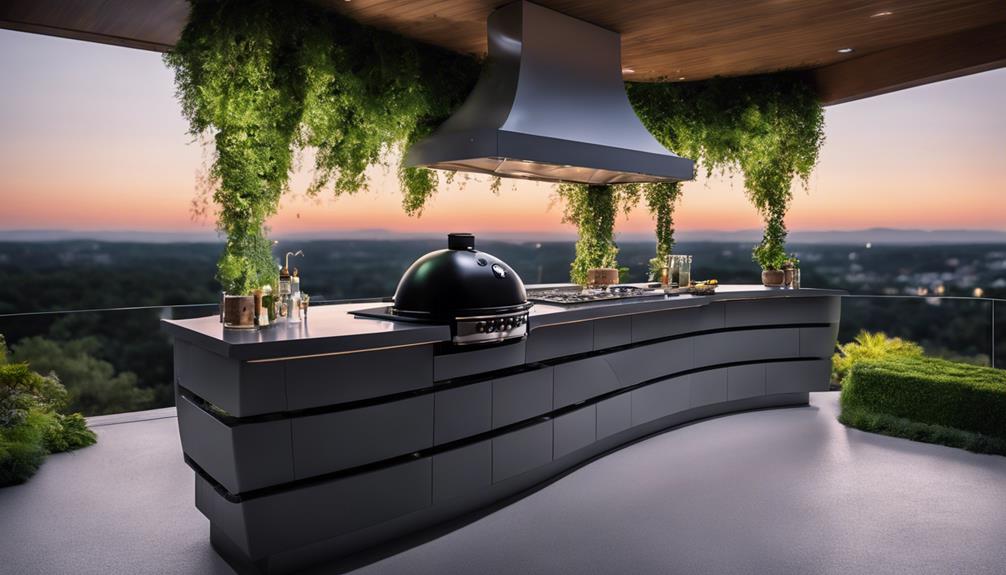
When it comes to outfitting your alfresco kitchen, selecting high-performance countertop materials is essential, and you've got several excellent options to choose from. You want a surface that can withstand the elements and still look fabulous.
Here are some top picks for your outdoor kitchen countertops:
- Granite countertops: Durable, fire-resistant, and water-resistant – what more could you ask for?
- Quartz surfaces: Modern, strong, and resistant to sunlight discoloration – perfect for a sleek outdoor kitchen.
- Stainless steel: Sleek, easy to clean, and perfect for a contemporary look.
Additionally, consider concrete countertops for a sleek, weather-resistant option, or natural stone options like marble or slate for an elegant touch. Each material has its unique benefits, so choose the one that fits your style and needs.
Frequently Asked Questions
What Is Trending in Outdoor Cooking?
You're wondering what's trending in outdoor cooking, right? Well, let me tell you – gas grills are still super popular for quick cooking and low maintenance.
But, people are also getting creative with alternate-fuel options like smokers and pellet grills for unique flavors.
And, side burners and griddles are making a comeback, expanding your outdoor cooking possibilities!
What Is the Most Common Shape for an Outdoor Kitchen?
So, you're wondering what's the most common shape for an outdoor kitchen? Well, you're in luck! The L-shaped design takes the top spot, offering a super efficient workflow and plenty of counter space.
It's a popular choice for a reason! You get to move around easily, prep, cook, and serve without feeling cramped. Plus, it's easy to add appliances and seating areas, making it a perfect fit for your outdoor cooking adventures!
Are Outdoor Kitchens Still Popular?
You might be wondering, are outdoor kitchens still all the rage? Well, here's a stat that'll give you a hint: 70% of homeowners consider outdoor living spaces, including kitchens, a must-have! That's a lot of people wanting to take their cooking and entertaining outside!
And the answer is, yes, outdoor kitchens are still super popular. The pandemic has actually fueled the demand for these spaces, as people seek to enhance their outdoor living experiences.
What Is the Best Base for an Outdoor Kitchen?
So, you're wondering what's the best base for your outdoor kitchen, right? Well, you've got a few awesome options to choose from!
Concrete is super durable and sturdy, while natural stone like granite or marble gives off a luxurious vibe.
If you're feeling modern, stainless steel is sleek and easy to maintain. Or, if you want a rustic charm, brick or tile could be the way to go.
And if you want something low-maintenance, composite materials are a great choice!
Conclusion
You've got the blueprint for your dream alfresco kitchen! Just remember, 'measure twice, cut once' – and don't be afraid to think outside the box (or in this case, the kitchen walls)!
With these top trends, you'll be whipping up gourmet meals and making unforgettable memories in no time.
So, get ready to fire up the grill, pour the drinks, and soak up the sunshine in your new outdoor haven!
